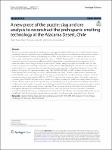Item Infomation
Full metadata record
| DC Field | Value | Language |
|---|---|---|
| dc.contributor.author | Plaza, María Teresa | - |
| dc.contributor.author | Garrido, Francisco | - |
| dc.contributor.author | Larreina-García, David | - |
| dc.date.accessioned | 2023-08-25T04:21:58Z | - |
| dc.date.available | 2023-08-25T04:21:58Z | - |
| dc.date.issued | 2023 | - |
| dc.identifier.uri | https://link.springer.com/article/10.1186/s40494-023-01017-z | - |
| dc.identifier.uri | https://dlib.phenikaa-uni.edu.vn/handle/PNK/8947 | - |
| dc.description | CC-BY | vi |
| dc.description.abstract | The Incas appropriated many local metallurgical technologies throughout the Andes, each of which had its unique peculiarities and was based on local ancestral knowledge. The widespread use of tin-bronze during the Inca expansion, the development of mining and smelting sites, as well as ethno-historical records evidence the Incas’ interest in copper smelting, a key activity in the Andes since ca. 1400 BC. However, little is known about the technical parameters achieved by ancient metallurgists and the changes that occurred during the Inca expansion. In this paper, we address these changes through a case study of Copiapó valley, focusing on the Viña del Cerro site, one of the most famous Inca smelting centres of the southern Andes. Although this place was architectonically restructured by the Incas, its operations began long before the imperial expansion and used wind-powered furnaces. We analysed 19 slag and 11 copper ore samples using OM, SEM–EDS, WD-XRF, and XRD analyses. Results identified heterogeneous and viscous slags, rich in SiO2 (43 wt%) and poor in FeO (13 wt%). | vi |
| dc.language.iso | vi | vi |
| dc.publisher | Springer | vi |
| dc.subject | XRD analyses | vi |
| dc.subject | Incas | vi |
| dc.title | A new piece of the puzzle: slag and ore analysis to reconstruct the prehispanic smelting technology at the Atacama Desert, Chile | vi |
| Appears in Collections | ||
| OER - Khoa học Vật liệu, Ứng dụng | ||
Files in This Item:

